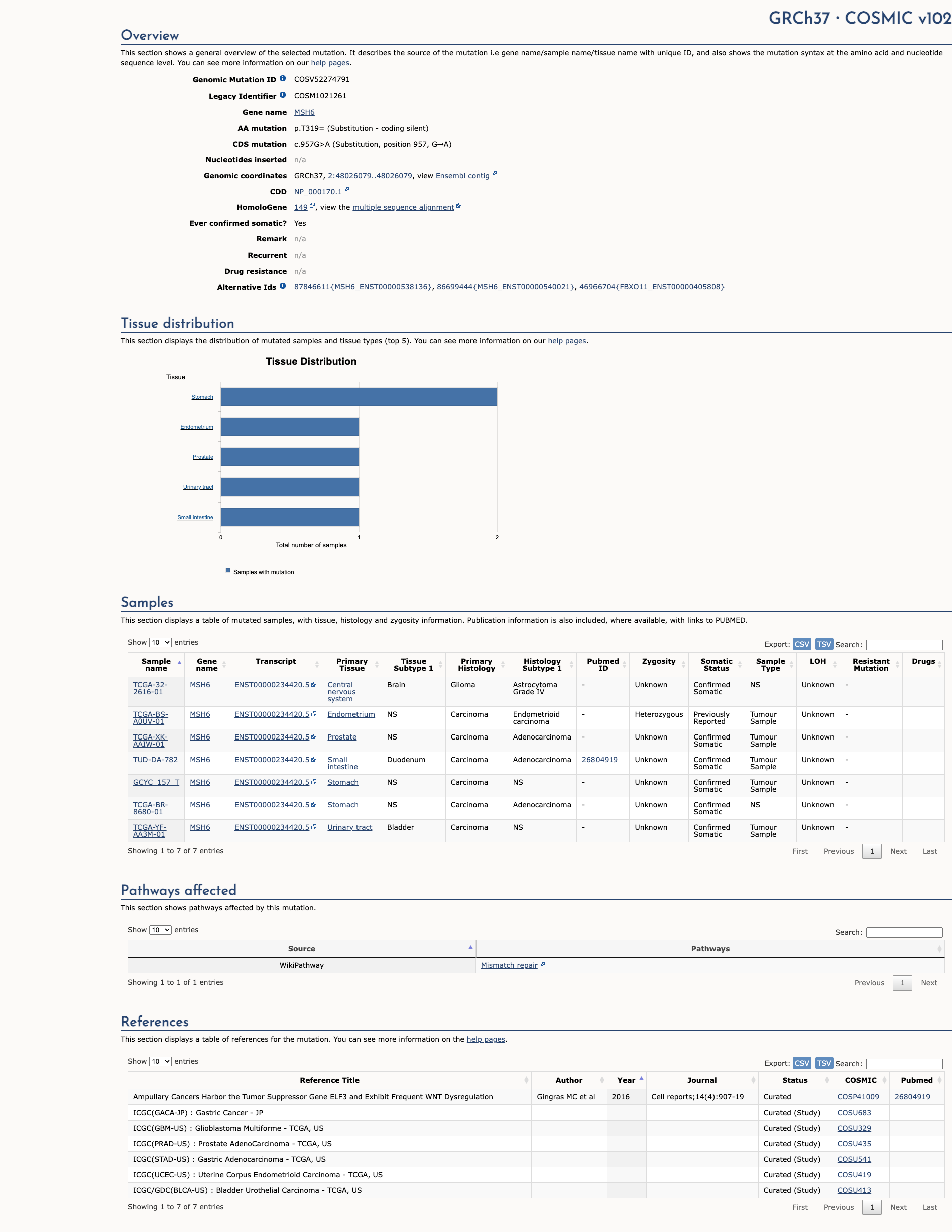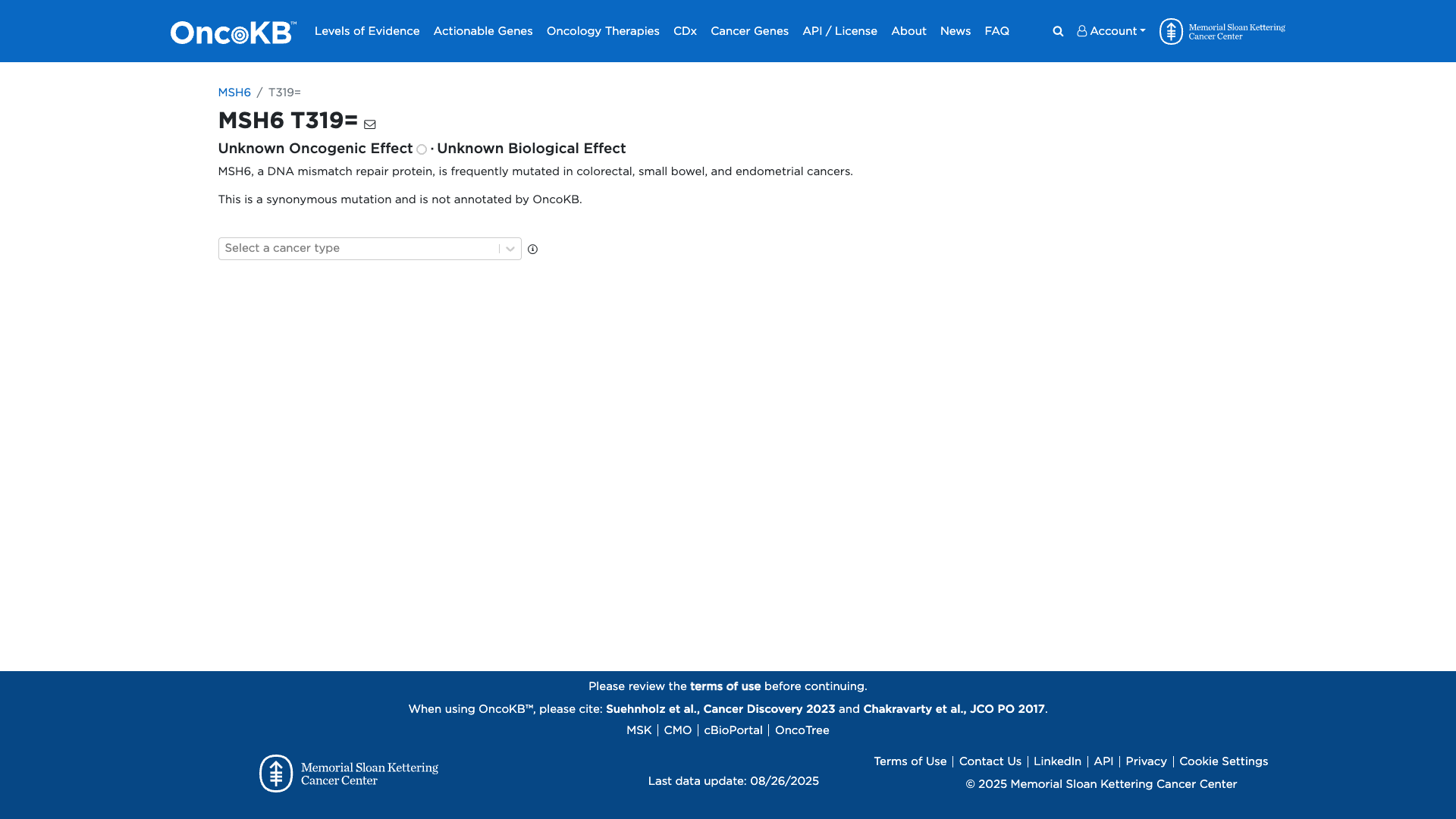MSH6 c.957G>A, p.Thr319=
NM_000179.2:c.957G>A
COSMIC ID: COSM1021261
Likely Benign
This synonymous MSH6 variant shows no impact on splicing (SpliceAI delta=0), is rare but above the VCEP PM2 threshold, and has supportive benign classifications in ClinVar. Only BP4 and BP6 at Supporting strength apply, consistent with a Likely Benign classification.
ACMG/AMP Criteria Applied
BP4
BP6
Genetic Information
Gene & Transcript Details
Gene
MSH6
Transcript
NM_000179.3
MANE Select
Total Exons
10
Strand
Forward (+)
Reference Sequence
NC_000002.11
Alternative Transcripts
| ID | Status | Details |
|---|---|---|
| NM_000179.2 | RefSeq Select | 10 exons | Forward |
| NM_000179.1 | Alternative | 10 exons | Forward |
Variant Details
HGVS Notation
NM_000179.2:c.957G>A
Protein Change
T319=
Location
Exon 4
(Exon 4 of 10)
5'Exon Structure (10 total)3'
Functional Consequence
Loss of Function
Related Variants
Alternate Identifiers
COSM1021261
Variant interpretation based on transcript NM_000179.3
Genome Browser
Loading genome browser...
HGVS InputNM_000179:c.957G>A
Active Tracks
ConservationRefSeqClinVargnomAD
Navigation tips: Use mouse to drag and zoom. Click on features for details.
Clinical Data
Global Frequency
0.00279%
Rare
Highest in Population
South Asian
0.0098%
Rare
Global: 0.00279%
South Asian: 0.0098%
0%
0.05%
0.1%
1%
5%
10%+
Allele Information
Total: 251300Alt: 7Homozygotes: 0
ACMG Criteria Applied
PM2
This variant is present in gnomAD (MAF= 0.00279%, 7/251300 alleles, homozygotes = 0) and at a higher frequency in the South Asian population (MAF= 0.0098%, 3/30614 alleles, homozygotes = 0). The variant is rare (MAF < 0.1%), supporting PM2 criterion application.
Classification
Likely Benign
Based on 6 submitter reviews in ClinVar
Submitter Breakdown
4 LB
2 B
Pathogenic
Likely Path.
VUS
Likely Benign
Benign
Publications (0)
No publication details.
Clinical Statement
This variant has been reported in ClinVar as Benign (2 clinical laboratories) and as Likely benign (4 clinical laboratories).
Functional Impact
Functional Domain
Hotspot Status
Not a hotspot
Domain Summary
This variant is not located in a mutational hotspot or critical domain (0 mutations).
Related Variants in This Domain
Computational Analysis
Pathogenicity Predictions
Predictor Consensus
Mixed/VUS
PP3 Applied
No
Additional Predictors
Benign:
CADD: 0.33
VCEP Guidelines
Applied ACMG/AMP Criteria (VCEP Specific) VCEP Guidelines
PVS1
PVS1 (Not Applied) Strength Modified
According to VCEP guidelines, the rule for PVS1 is: "Very Strong Nonsense/frameshift variant introducing Premature Termination Codon (PTC) ≤ codon 1341 in MSH6. Refer to Appendix for details. OR Large genomic alterations of single or multi-exon size. OR Variants at IVS±1 or IVS±2 a,c where exon skipping or use of a cryptic splice site disrupts reading frame and is predicted to undergo NMD." The evidence for this variant shows: it is a synonymous variant (T319=) with no PTC or frameshift. Therefore, this criterion is not applied.
PS1
PS1 (Not Applied) Strength Modified
According to VCEP guidelines, the rule for PS1 is: "Strong A predicted missense substitution that encodes the same amino acid change with a different underlying nucleotide change previously established by this VCEP as Pathogenic (not a predicted or confirmed splice defect). OR Variants affecting the same non-canonical splice nucleotide as a confirmed pathogenic splice variant with similar or worse splicing in silico prediction using SpliceAI." The evidence for this variant shows: it is a synonymous change, not a missense. Therefore, this criterion is not applied.
PS2
PS2 (Not Applied) Strength Modified
According to VCEP guidelines, the rule for PS2 is: "Very Strong ≥ 4 de novo points." The evidence for this variant shows: no de novo occurrence data are available. Therefore, this criterion is not applied.
PS3
PS3 (Not Applied) Strength Modified
According to VCEP guidelines, the rule for PS3 is: "Strong Calibrated functional assays with functional odds for Pathogenicity > 18.7." The evidence for this variant shows: no functional assays have been performed. Therefore, this criterion is not applied.
PS4
PS4 (Not Applied) Strength Modified
According to standard ACMG guidelines, the rule for PS4 is: "The prevalence of the variant in affected individuals is significantly increased compared with controls." The evidence for this variant shows: no case-control or segregation data demonstrating enrichment in affected individuals. Therefore, this criterion is not applied.
PM1
PM1 (Not Applied) Strength Modified
According to standard ACMG guidelines, the rule for PM1 is: "Located in a mutational hot spot and/or critical and well-established functional domain without benign variation." The evidence for this variant shows: it is a synonymous variant outside of any known functional domain. Therefore, this criterion is not applied.
PM2
PM2 (Not Applied) Strength Modified
According to VCEP guidelines, the rule for PM2 is: "Supporting Absent/extremely rare (<1 in 50,000 alleles) in gnomAD v4 dataset." The evidence for this variant shows: allele frequency in gnomAD v4 is 7/251300 (0.00279%), which exceeds the 1/50,000 (0.002%) threshold. Therefore, this criterion is not applied.
PM3
PM3 (Not Applied) Strength Modified
According to VCEP guidelines, the rule for PM3 is: "Very Strong ≥ 4 points for recessive gene-specific observation in trans with a pathogenic variant." The evidence for this variant shows: no observations of this variant in trans with a pathogenic MSH6 variant. Therefore, this criterion is not applied.
PM4
PM4 (Not Applied) Strength Modified
According to standard ACMG guidelines, the rule for PM4 is: "Protein length changes due to in-frame deletions/insertions in a non-repeat region or stop-loss variants." The evidence for this variant shows: it is a synonymous substitution, not an indel or stop-loss. Therefore, this criterion is not applied.
PM5
PM5 (Not Applied) Strength Modified
According to VCEP guidelines, the rule for PM5 is: "Moderate Missense change at an amino acid residue where a different missense change was classified by this VCEP as Pathogenic on the protein level and not due to aberrant splicing. Only use PM5 if PP3 is supporting for the missense change. Use PM5_Supporting if the other variant is Likely Pathogenic due to a missense alteration." The evidence for this variant shows: it is a synonymous variant, not a missense. Therefore, this criterion is not applied.
PM6
PM6 (Not Applied) Strength Modified
According to VCEP guidelines, the rule for PM6 is: "Supporting 0.5 de novo points." The evidence for this variant shows: no de novo data are available. Therefore, this criterion is not applied.
PP1
PP1 (Not Applied) Strength Modified
According to standard ACMG guidelines, the rule for PP1 is: "Co-segregation with disease in multiple affected family members in a gene known to cause the disease." The evidence for this variant shows: no segregation data are available. Therefore, this criterion is not applied.
PP2
PP2 (Not Applied) Strength Modified
According to standard ACMG guidelines, the rule for PP2 is: "Missense variant in a gene with a low rate of benign missense variation and where missense variants are a common mechanism of disease." The evidence for this variant shows: it is synonymous, not missense. Therefore, this criterion is not applied.
PP3
PP3 (Not Applied) Strength Modified
According to VCEP guidelines, the rule for PP3 is: "Moderate Missense variant with HCI prior probability for pathogenicity >0.81 OR Supporting Missense variant with HCI prior probability >0.68 & ≤0.81 OR Predicted splice defect for non-canonical splice nucleotides using SpliceAI with delta score ≥ 0.2." The evidence for this variant shows: SpliceAI predicts no splice impact (delta score 0), and CADD is neutral; no in silico evidence of pathogenicity. Therefore, this criterion is not applied.
PP4
PP4 (Not Applied) Strength Modified
According to VCEP guidelines, the rule for PP4 is: "Strong ≥3 independent CRC/Endometrial MSI-H tumors in ≥2 families or equivalent MMR protein loss consistent with variant." The evidence for this variant shows: no tumor phenotype data are available. Therefore, this criterion is not applied.
PP5
PP5 (Not Applied) Strength Modified
According to standard ACMG guidelines, the rule for PP5 is: "Reputable source recently reports variant as pathogenic but the evidence is not available to the laboratory to perform an independent evaluation." The evidence for this variant shows: reputable sources report it as benign/likely benign, not pathogenic. Therefore, this criterion is not applied.
BA1
BA1 (Not Applied) Strength Modified
According to VCEP guidelines, the rule for BA1 is: "Stand Alone GnomAD v4 Grpmax filtering allele frequency ≥ 0.0022 (0.22%) and variant is excluded as founder pathogenic variant." The evidence for this variant shows: allele frequency (0.00279%) is below 0.22%. Therefore, this criterion is not applied.
BS1
BS1 (Not Applied) Strength Modified
According to VCEP guidelines, the rule for BS1 is: "Strong GnomAD v4 Grpmax filtering allele frequency ≥ 0.00022 and < 0.0022 (0.022–0.22%) and variant is excluded as founder pathogenic variant." The evidence for this variant shows: allele frequency (0.00279%) is above 0.00022 but below 0.0022? Actually 0.00279% = 0.0000279, which is below 0.00022. Therefore, this criterion is not applied.
BS2
BS2 (Not Applied) Strength Modified
According to VCEP guidelines, the rule for BS2 is: "Strong Co-occurrence in trans with a known pathogenic sequence variant in the same gene in a patient with CRC after age 45, without evidence of CMMRD." The evidence for this variant shows: no co-occurrence data. Therefore, this criterion is not applied.
BS3
BS3 (Not Applied) Strength Modified
According to VCEP guidelines, the rule for BS3 is: "Strong Calibrated functional assays with functional odds for Pathogenicity ≤ 0.05 OR Synonymous substitutions and intronic variants with no associated mRNA aberration as determined by laboratory assays." The evidence for this variant shows: no experimental mRNA assays have been conducted. Therefore, this criterion is not applied.
BS4
BS4 (Not Applied) Strength Modified
According to VCEP guidelines, the rule for BS4 is: "Strong Lack of co-segregation with disease in pedigree(s) with a combined Bayes LR h <0.05." The evidence for this variant shows: no segregation data. Therefore, this criterion is not applied.
BP1
BP1 (Not Applied) Strength Modified
According to standard ACMG guidelines, the rule for BP1 is: "Missense variant in a gene for which primarily truncating variants are known to cause disease." The evidence for this variant shows: it is synonymous, not missense. Therefore, this criterion is not applied.
BP2
BP2 (Not Applied) Strength Modified
According to standard ACMG guidelines, the rule for BP2 is: "Observed in trans with a pathogenic variant for a dominant disorder." The evidence for this variant shows: no such observations. Therefore, this criterion is not applied.
BP3
BP3 (Not Applied) Strength Modified
According to standard ACMG guidelines, the rule for BP3 is: "In-frame deletions/insertions in a repetitive region without a known function." The evidence for this variant shows: it is a single-nucleotide change, not an indel. Therefore, this criterion is not applied.
BP4
BP4 (Supporting)
According to VCEP guidelines, the rule for BP4 is: "Supporting For intronic and synonymous variants: SpliceAI predicts no splicing impact with delta score ≤ 0.1 as per Walker et al 2023." The evidence for this variant shows: SpliceAI maximum delta score = 0, indicating no impact on splicing. Therefore, this criterion is applied at Supporting strength because computational splicing prediction supports a benign effect.
BP5
BP5 (Not Applied) Strength Modified
According to VCEP guidelines, the rule for BP5 is: "Supporting Variant found in a case with an alternate molecular basis for disease." The evidence for this variant shows: no such case data. Therefore, this criterion is not applied.
BP6
BP6 (Supporting)
According to standard ACMG guidelines, the rule for BP6 is: "Supporting Reputable source recently reports variant as benign but the evidence is not available to the laboratory to perform an independent evaluation." The evidence for this variant shows: ClinVar entries include 2 labs reporting Benign and 4 labs reporting Likely Benign without available primary evidence. Therefore, this criterion is applied at Supporting strength because of the reputable source classification.
BP7
BP7 (Not Applied) Strength Modified
According to VCEP guidelines, the rule for BP7 is: "Supporting A synonymous (silent) or intronic variant at or beyond -21/+7 (5′/3′ exonic). Variants may satisfy both BP7 and BP4." The evidence for this variant shows: transcript exon–intron boundary positions relative to c.957G>A are not provided. Therefore, this criterion is not applied.



